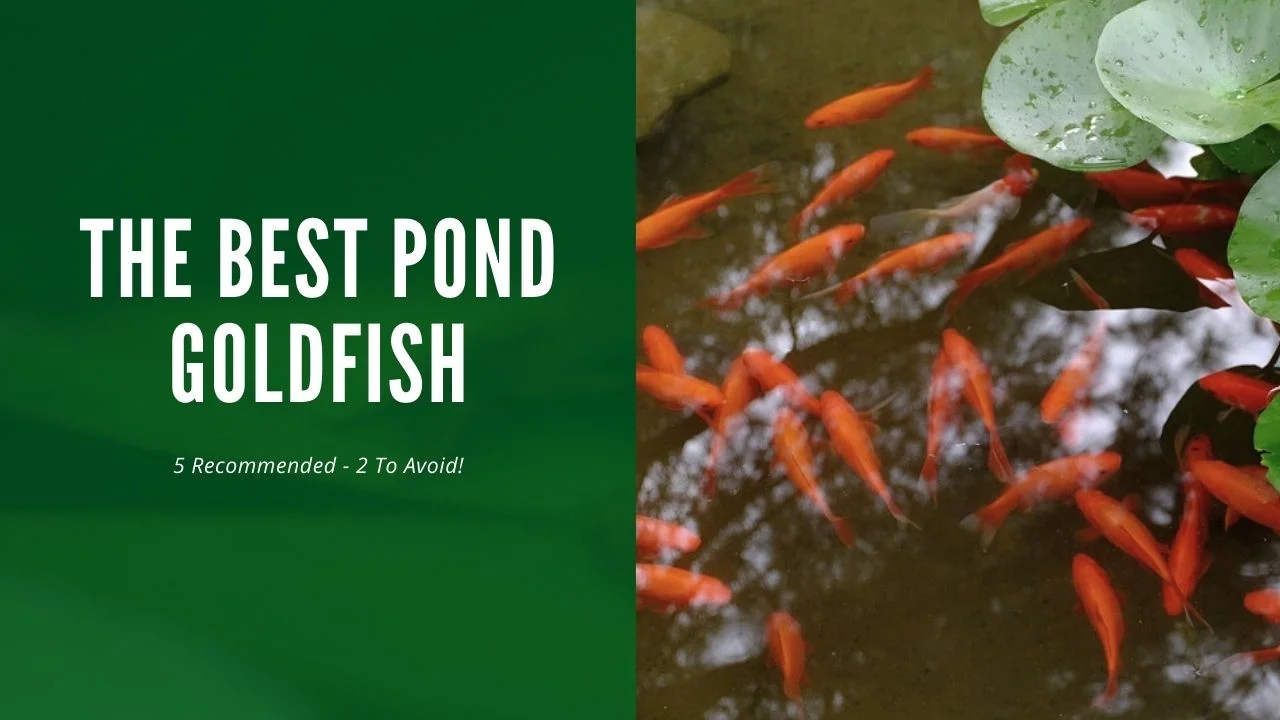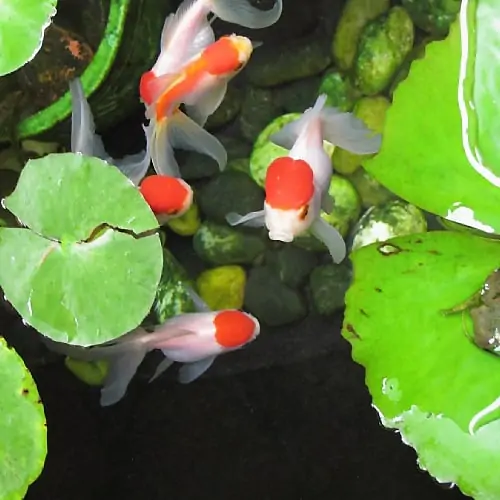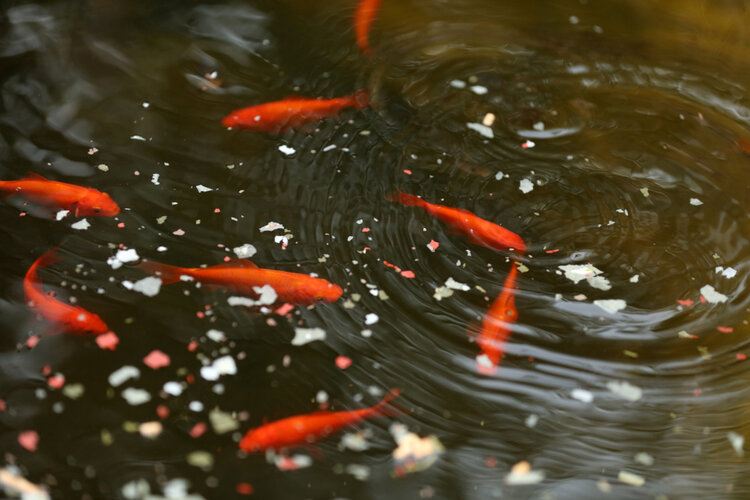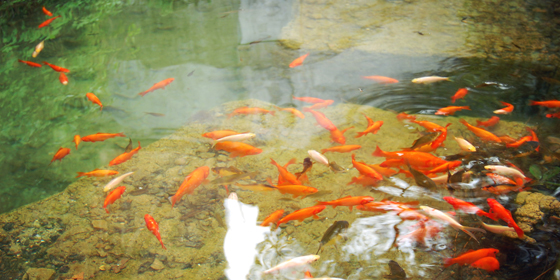Have you ever wondered what types of goldfish can thrive in a pond? Well, you're in luck! There are actually several varieties of goldfish that are well-suited for pond life. In this article, we will explore some of the most popular types of goldfish that can live happily in a pond and provide you with all the information you need to create a beautiful and thriving goldfish pond in your own backyard.
One of the most common types of goldfish that can live in a pond is the common goldfish. These goldfish are hardy and can adapt well to various water conditions, making them an ideal choice for pond owners. Another popular variety is the koi goldfish. Koi goldfish are known for their stunning colors and can grow quite large, adding a visually striking element to your pond.
Did you know that there are also fancy goldfish that can live happily in a pond? Fancy goldfish, such as the fantail and the oranda, have unique and beautiful tail shapes that make them a popular choice for pond owners looking to add some elegance to their water feature. Lastly, the shubunkin goldfish is another favorite for pond enthusiasts. Known for its calico-like coloring, the shubunkin is a lively and active fish that can do well in a pond environment.
So, whether you're looking for a hardy common goldfish, a stunning koi, a fancy goldfish with unique tail shapes, or a colorful shubunkin, there is certainly a type of goldfish that can thrive in your pond. In the following article, we will dive deeper into each variety and provide you with tips on how to care for them to ensure their health and happiness. Stay tuned!

This image is property of aquariumstoredepot.com.
Introduction
Understanding the suitability of goldfish for pond environments
If you have a picturesque pond in your backyard, you may have considered adding some beautiful goldfish to enhance its charm. Goldfish are known for their vibrant colors and graceful swimming, making them popular choices for pond owners. However, not all goldfish varieties thrive in pond environments. In this article, we will explore the types of goldfish that can live happily in a pond, their characteristics, requirements, and tips for their care.
Common Goldfish
Features and characteristics of common goldfish
Common goldfish, also known as Carassius auratus, are one of the oldest and most common goldfish varieties. They have a sturdy body shape, usually ranging from a vibrant orange to gold or silver. Common goldfish often have long, flowing tails and can grow up to 10 to 12 inches in length. They are known for their hardiness, making them an excellent choice for outdoor ponds.
Requirements for common goldfish in a pond
Common goldfish thrive in ponds that offer them ample space to swim and explore. As they can grow quite large, it is essential to provide them with a pond that has a minimum capacity of 1000 gallons. Adequate filtration systems and regular water changes are crucial for maintaining optimal water quality for common goldfish.
Benefits of keeping common goldfish in a pond
Keeping common goldfish in a pond offers several benefits. Apart from being visually stunning, these goldfish are great for pond ecosystems. They contribute towards maintaining the balance by eating algae, thereby helping to keep the water clean. Additionally, they can withstand varying temperature fluctuations, making them suitable for both warm and cold climates.

This image is property of pondinformer.com.
Comet Goldfish
Distinctive traits and appearance of comet goldfish
Comet goldfish, scientifically known as Carassius auratus auratus, are named after their long and flowing tails that resemble a comet streaking through the sky. This variety is available in various colors, including orange, red, yellow, and even calico patterns. Comet goldfish have a streamlined body shape and can grow up to 12 inches or more in length.
Adaptability of comet goldfish to pond habitats
Comet goldfish are known for their adaptability to pond environments. They prefer an outdoor pond setting with ample space to swim and explore. They are also quite hardy and can tolerate colder temperatures, making them suitable for ponds in regions with distinct seasons.
Factors to consider when keeping comet goldfish in a pond
When keeping comet goldfish in a pond, you need to consider factors such as pond size, water quality, and feeding. Providing a pond with a minimum capacity of 500 gallons will allow these goldfish to thrive. Regular water testing and maintenance of proper filtration systems are essential to ensure a healthy environment for them. Comet goldfish are omnivorous and should be fed a balanced diet that includes both commercial fish pellets and fresh vegetables.
Shubunkin Goldfish
Description and vibrant coloration of shubunkin goldfish
Shubunkin goldfish are known for their stunning and vibrant coloration, which includes shades of blue, red, orange, and sometimes black. They have a streamline body shape similar to comet goldfish, with long fins and a forked tail. The shubunkin goldfish can grow up to 12 inches in length and are incredibly eye-catching.
Suitability of shubunkin goldfish for pond conditions
Shubunkin goldfish are well-suited for pond conditions due to their hardiness and adaptability. They can withstand various water parameters and temperature fluctuations, making them an excellent choice for outdoor ponds. These goldfish enjoy swimming in a spacious pond environment and appreciate the presence of plants and rocks for added stimulation.
Tips for successfully raising shubunkin goldfish in a pond
To successfully raise shubunkin goldfish in a pond, it is important to ensure water quality and provide a balanced diet. Regular water testing and maintenance of a proper filtration system will help create a healthy environment for these goldfish to thrive. Feeding them a variety of foods, including high-quality commercial fish pellets, live or frozen brine shrimp, and vegetables, will provide them with the necessary nutrients for optimal growth and vibrant coloration.

This image is property of www.velda.nl.
Fantail Goldfish
Characteristics and unique physical attributes of fantail goldfish
Fantail goldfish are easily recognizable by their distinct physical attributes. They have a rounded body shape, double anal and caudal fins, and a pronounced hump on their back. This hump, also known as the wen, is a unique feature of fantail goldfish and becomes more prominent as they mature. They come in a variety of colors, including orange, red, black, and calico.
Creating an ideal environment for fantail goldfish in ponds
For fantail goldfish to thrive in a pond, it is important to provide them with a spacious environment. A pond with a minimum capacity of 500 gallons is recommended to allow them ample space for swimming and exploring. Moderately sized plants and smooth rocks can be added to the pond to provide hiding spots and visual interest for these goldfish.
Providing adequate care and nutrition for your fantail goldfish
Proper care and nutrition are essential for the well-being of fantail goldfish in ponds. Regular water testing and proper filtration systems should be implemented to maintain water quality. Fantail goldfish are omnivorous and should be fed a balanced diet consisting of high-quality commercial fish pellets, live or frozen brine shrimp, and vegetables. It is important to avoid overfeeding them to prevent digestive issues and water pollution.
Oranda Goldfish
Oranda goldfish: a regal and fancy pond inhabitant
Oranda goldfish are known for their regal and fancy appearance. They have a rounded body, a pronounced wen that covers their head, and long, flowing fins. Orandas are available in various colors, including red, orange, blue, black, and even multiple combinations. This goldfish variety is highly prized among enthusiasts for its unique and stunning look.
Maintaining water quality and temperature for oranda goldfish
To ensure the health and well-being of oranda goldfish in a pond, it is crucial to maintain optimal water quality. Regular water testing, filtration, and necessary water changes are necessary to prevent the buildup of harmful toxins. Oranda goldfish prefer relatively moderate temperatures between 65°F to 75°F, making them suitable for ponds in regions with moderate climates.
Important considerations for keeping oranda goldfish outdoors
When keeping oranda goldfish outdoors, it is important to provide them with a suitable pond environment. A pond with a minimum capacity of 1000 gallons is recommended to allow these goldfish ample space for swimming and displaying their impressive fins. Providing adequate shade and shelter from extreme weather conditions, such as direct sunlight and freezing temperatures, is essential for their well-being.

This image is property of www.hepper.com.
Lionhead Goldfish
Understanding the distinct lionhead feature of this goldfish type
Lionhead goldfish are easily recognized by their distinctive feature - the prominent growth on their head called the "wen." The wen starts to develop when these goldfish are six to eight months old and continues to grow as they mature. Lionheads have a rounded body shape, short stubby fins, and come in various colors, including red, orange, calico, and black.
Creating a suitable pond environment for lionhead goldfish
To create a suitable environment for lionhead goldfish in a pond, it is important to provide adequate space and shelter. A pond with a minimum capacity of 500 gallons will allow them to swim comfortably and grow. Lionheads enjoy having plants and rocks in the pond to explore and provide hiding spots. It is important to ensure water quality by regular testing, proper filtration systems, and water changes.
Feeding and maintaining health of lionhead goldfish in a pond
Proper nutrition and care are essential for maintaining the health of lionhead goldfish in a pond. They are omnivorous and should be fed a balanced diet consisting of high-quality commercial fish pellets, live or frozen brine shrimp, and vegetables. Overfeeding should be avoided to prevent digestive issues. Regular monitoring of water quality and the overall health of the goldfish is important to detect any potential issues early on.
Ryukin Goldfish
Physical characteristics and appearance of ryukin goldfish
Ryukin goldfish are known for their unique and eye-catching physical characteristics. They have a humpbacked body shape, a slightly pointed head, and flowing fins. Ryukins come in various colors, including red, orange, red-and-white, and calico. The hump on their back tends to be more prominent as they mature, adding to their charm.
Pond requirements and compatibility of ryukin goldfish
For ryukin goldfish to thrive in a pond, certain requirements need to be met. A pond with a minimum capacity of 500 gallons is recommended to provide them with enough space to swim and display their unique body shape. Ryukins enjoy the presence of moderately sized plants and smooth rocks in the pond, providing them with hiding spots and visual interest. Like other goldfish, maintaining proper water quality through regular testing, filtration, and water changes is crucial.
Tips for raising ryukin goldfish successfully in a pond
To raise ryukin goldfish successfully in a pond, it is important to provide them with a nutritious diet and optimum care. Ryukins are omnivorous and should be fed a balanced diet consisting of high-quality commercial fish pellets, live or frozen brine shrimp, and vegetables. Avoid overfeeding to maintain water quality and prevent digestive issues. Regular monitoring of their health and water parameters will help ensure their well-being.

This image is property of howtotakecareofgoldfish.com.
Conclusion
Choosing the right goldfish for your pond based on preferences
When selecting goldfish for your pond, it is important to consider your preferences and the specific requirements of each goldfish variety. Each type of goldfish mentioned in this article has its own unique characteristics and care needs, making them suitable for different pond environments.
Ensuring optimal care and conditions to support goldfish well-being
To support the well-being of goldfish in your pond, it is crucial to provide them with a suitable environment that meets their specific requirements. This includes proper pond size, water quality maintenance, filtration systems, and appropriate nutrition.
Enjoyment and benefits of having goldfish in your pond
Having goldfish in your pond can bring immense enjoyment and beauty to your outdoor space. The bright colors, graceful swimming, and natural behavior of goldfish can create a serene and captivating atmosphere. Additionally, goldfish contribute to the overall health of the pond ecosystem by consuming algae and adding vitality to the environment.
Whether you choose common goldfish, comet goldfish, shubunkin goldfish, fantail goldfish, or any other variety mentioned in this article, providing them with the right care and environment will ensure their longevity and vibrant presence in your pond. So go ahead and welcome these fascinating creatures into your pond and enjoy the beauty they bring to your outdoor space.


No comments:
Post a Comment